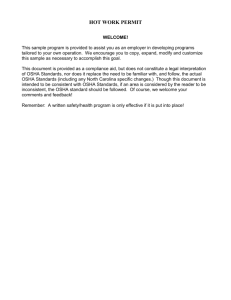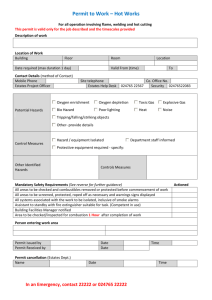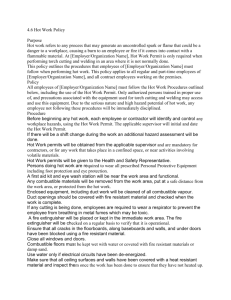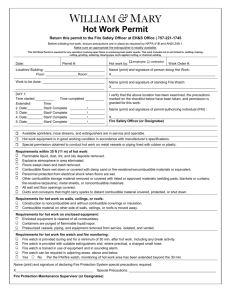The University of Montana Safety Manual - Chapter 14
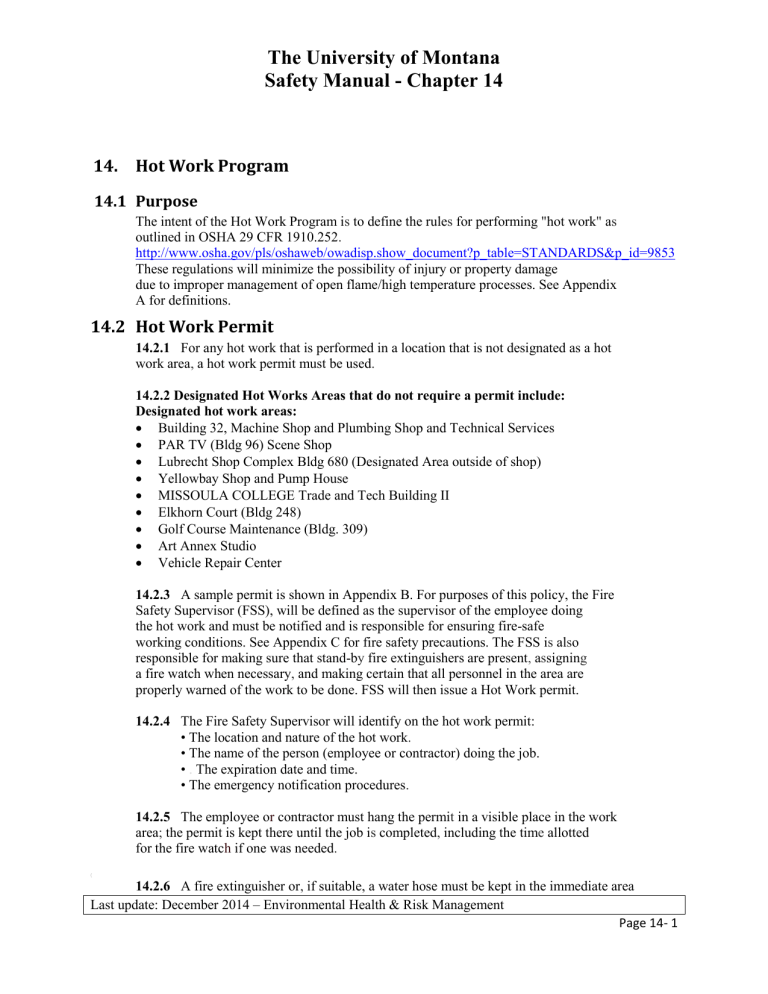
The University of Montana
Safety Manual - Chapter 14
14.
Hot Work Program
14.1
Purpose
The intent of the Hot Work Program i s to define the rule s for performing " hot work " a s outlined in OSHA 29 CFR 1910.252
. http://www.osha.gov/pls/oshaweb/owadisp.show_document?p_table=STANDARDS&p_id=9853
These regulations will minimize the possibility of injury or property damage due to improper management of open flame/high temperature processes. See Appendix
A for definitions.
(
14.2
Hot Work Permit
14.2.1
For any hot work that is performed in a location that is not designated as a hot work area , a hot work permit must be used .
14.2.2 Designated Hot Works Areas that do not require a permit include:
Designated hot work areas:
Building 32, Machine Shop and Plumbing Shop and Technical Services
PAR TV (Bldg 96) Scene Shop
Lubrecht Shop Complex Bldg 680 (Designated Area outside of shop)
Yellowbay Shop and Pump House
MISSOULA COLLEGE Trade and Tech Building II
Elkhorn Court (Bldg 248)
Golf Course Maintenance (Bldg. 309)
Art Annex Studio
Vehicle Repair Center
14.2.3
A sample permit is shown in Appendix B. For purposes of this policy, the Fire
Safety Supervisor (FSS), will be defined as the supervisor of the employee doing the hot work and must be notified and is responsible for ensuring fire-safe working conditions. See Appendix C for fire safety precautions. The FSS i s al s o responsible for making sure that stand-b y fire extinguishers are present , a s signin g a fire watch when necessary , and making certain that all personnel in the area are properly warned of the work to be done. FSS will then issue a Hot Work permit.
14.2.4
The Fire Safety Supervisor will identify on the hot work permit:
• The location and nature of the hot work .
• The name of the person (employee or contractor) doing the job.
• . The expiration date and time.
• The emergency notification procedures
.
14.2.5
The employee o r contractor must hang the permi t in a visible place in the work area ; the permit is kept there until the job i s completed , including the tim e allotted for the fire watc h if one was needed .
14.2.6 A fire extinguisher or , if suitable, a water hose must be kept in the immediate area
Last update: December 2014 – Environmental Health & Risk Management
Page 14- 1
The University of Montana
Safety Manual - Chapter 14 of the work. If there is a fire extinguisher located in the room , the worker must identify the location prior to starting work.
14.2.7
The fire watcher observes the worker performing the hot work and keeps a constant vigil fo r stray sparks, ignition or other fire hazards . He / she must remain in the work area for at least a half-hour after the work is done to check for smoldering fires. Due to manpower constraints, a second individual may not be available to act as a fire watcher. In the event the work is being done by a single employee , that employee shall inspect the job site in no less than 30 minute s after the source of heat is extinguished.
14.2.8
If the hot work will done in a confined space , all confined space entry procedures must be followed.
14.2.9
The completed permit must be turned in at the end of the job to the Fire Safety
Supervisor who will forward the completed permit to The University of Montana
Risk Manager.
14.3
Personal Protective Equipment
Protection of the eyes, face, neck, and hands is required during any type of hot work. A welding helmet and heavy insulated gloves provide some of this protection. See
Appendix D for shade requirements for various welding processes.
14.3.1
Only natural fiber clothing should be worn on the upper body extremities. A leather apron or full body leathers is recommended.
14.3.2 Respiratory protection is not required for most welding jobs if good ventilation is provided. Appendix E provides guidelines to assist in the determination of the need for respiratory protection.
14.3.3 Welding screens are required to protect adjacent workers from exposure to non-ionizing radiation. Adjacent workers are required to wear appropriate eye protection where screens are not feasible. Welder's assistants or anyone working in the screened area must wear appropriate eye p r otection.
14.4 Contractors
It is suggested that UM Planning and Construction (P&C) take the lead in making sure that this chapter is provided to all contractors, their employees , agents and subcontractors (contractors) to ensure all contractors follow the ‘UM Hot Works Program (ref. Chapter 14 of UM Safety
Manual). EHRM and P&C will communicate with all campus departments that may use contractors occasionally to ensure that these contractors also abide by this program as well.
14.5 Training
Required training will provided annually or whenever conditions or the program change s.
Last update: December 2014 – Environmental Health & Risk Management
Page 14- 2
The University of Montana
Safety Manual - Chapter 14
14.6 Emergency/After Hours Work
E mpl oy ee s ma y b e called in aft e r hour s or on we e kend s to deal w ith w ater line breaks / leaks or o t her emergencies. Wher e a supervisor is not a v ailable to i ss ue the hot work permit, the employee doing the work may proceed without a permit but must follow the Required Precautions Checklist. The goal is to reduc e f i re danger to a s grea t an e x tent as possible while not impeding the com p letion o f emergency repairs .
.
14.7 Documentation of Standard Procedures in Lieu of a Hot Work
Permit
Soldering pipes is the mo s t common hot work d o ne at the U ni v ersit y of Montan a . It represents the same risk as welding and grinding but in a mu c h small e r are a of concern ~ A well trained plumber who uses heat shields as appropriate , checks the immediate area w here the work is done and is able to recognize risks adjac e nt to the area where soldering is done can and h a s don e thi s s ort of work s afel y a t T h e
University of Montana for many years.
Individual shops who develop and document training of employees for fire safety pr a ctices to be used in the c o urse of soldering pipes may , upon review b y En v ironmental Health and Risk
Management , gain an e x emption from the requirements to use a Hot Work
Permit in normal plumbing operations . The training and document a tion mu s t b e reviewed at least annually by EHRM staff and found acceptable for the ex e mptio n to remain in effect. A fire safety kit will be immediately available (within e a sy reach) whenever soldering is done when combust i ble or flammable materi a l s ar e present. The kit shall contain , at a minimum , a fi r e extinguisher and hea t s hield (s) suitable for the task at hand.
Last update: December 2014 – Environmental Health & Risk Management
Page 14- 3
The University of Montana
Safety Manual - Chapter 14
14.8 APPENDIX A
14.8.1 Definitions
A. Hot Work refers to any job activity that uses or produces flames, sparks or heat that could act as an ignition source for any flammable liquid, gas or other combustible material in the area.
B. Fire Watch refers to having one or more people on the hot work job whose only purpose is to prevent a fire from starting from hot work performed in areas that are not designated as hot work areas or if any of the following conditions exist:
Noticeable combustible materials, in building construction or contents, are closer than 35 feet to the point of operation or are easily ignited by sparks;
Wall or floor openings within a 35-foot radius exposes combustible material in nearby areas, including concealed spaces in walls or floors;
Combustible material are adjacent to the opposite side of material partitions, walls, ceilings or roofs and are likely to be ignited by conduction or radiation;
The above are concerns when welding, cutting or grinding are done. The need for a fire watch is greatly reduced or eliminated when soldering pipe joints or similar work, provided heat shields are used as necessary and the work is inspected by the trained individual doing the work, approximately 30 minutes after the flame is extinguished.
C. Fire Watcher refers to person or persons who look for potential fires in all exposed areas during hot work and put out fires that are within the limits of the available fire extinguishers.
Last update: December 2014 – Environmental Health & Risk Management
Page 14- 4
The University of Montana
Safety Manual - Chapter 14
14.9 APPENDIX B – Hot Work Permit
Next two pages:
Part I –FORM
Part II-Display Sign
Last update: December 2014 – Environmental Health & Risk Management
Page 14- 5
The University of Montana
Safety Manual - Chapter 14
HOT WORK PERMIT
All temporary operations involving open flames or producing heat and/or sparks require a Hot Work Permit. This includes, but is not limited to, Brazing, Cutting, Grinding, Soldering, Thawing, and Welding.
THIS PERMIT IS GOOD FOR ONE DAY ONLY
Instructions for Fire Safety Supervisor OK HOT WORK CHECKLIST NA
1. Verify precautions listed at right ☐ Sprinklers, hose streams and extinguishers in ☐
THIS PERMIT IS GOOD FOR ONE DAY ONLY
2. Complete page 1 and retain for job file
3. Post page 2 if in Public Area
☐ Hot work equipment in good condition. ☐
Date W.O.#
REQUIREMENTS WITHIN 35 FEET OF WORK
☐ Dust, lint, debris, flammable liquids and oily ☐
Location/Bldg. and floor
Description of work being performed
deposits removed, floor swept clean.
☐ Explosive atmosphere in area eliminated. ☐
☐ Combustible floor wet down, covered with damp ☐
sand or fire blankets.
☐ Fans isolated or shut down. ☐
☐ Remove flammable and combustible material ☐
Name of person doing hot work
The above location has been examined, the precautions checked on the Hot Work Checklist have been taken to prevent fire, and permission
where possible. Otherwise protect with fire
blankets, guards or metal shields.
☐ All wall and floor openings covered. ☐
☐ Walkways protected beneath hot work. ☐ is authorized for work.
Signed:
(Permit authorizing individual)
WORK ON WALLS OR CEILINGS
☐ Combustibles moved away from other side of wall. ☐
Signed:
(Person doing hot work)
Time Started:
WORK IN CONFINED SPACES/ENCLOSED EQUIP.
☐ Confined space cleaned of all combustibles. ☐
☐ Enclosed equipment cleaned of all combustibles. ☐
☐ Containers purged of flammable liquids/vapors. ☐
Date:
Time Completed:
Date:
Time:
Time:
AM/PM
AM/PM
Fire Watch Signoff
Work area and all adjacent areas to which sparks and heat might have spread were inspected during the fire watch period and were found safe .
Signed:
Final Checkup (minimum of 30 minutes)
Work area was monitored for hour(s)
Following hot work and found fire safe.
Signed:
FIRE WATCH/HOT WORK AREA MONITORING
☐ Fire watch will be provided during and for 30 ☐
minutes after work, including breaks.
☐ Fire watch is supplied with suitable extinguisher. ☐
☐ Fire watch is trained in use of this extinguisher ☐
and in sounding alarm.
☐ Fire watch may be required for opposite side of ☐
walls, above, and below floors and ceilings.
OTHER PRECAUTIONS TAKEN
☐ Confined space or Lockout/Tagout required. ☐
☐ Area smoke or heat detection has been disabled. ☐
☐ Other. ☐
Last update: December 2014 – Environmental Health & Risk Management
Page 14- 6
The University of Montana
Safety Manual - Chapter 14
WARNING
HOT WORK IN
PROGRESS
WATCH FOR FIRE!
WARNING!
IN CASE OF AN EMERGENCY:
CALL: U of M POLICE DEPT.
AT
4000
Post if Hot Work occurs in a Public Area
Last update: December 2014 – Environmental Health & Risk Management
Page 14- 7
The University of Montana
Safety Manual - Chapter 14
14.10
APPENDIX C
14.10.1
Fire Safety Precautions for Hot Work
The following precautions should be taken before hot work begins:
1. Establish whether or not it is practical to move the work to a safer location.
2. Clear the area surrounding the work of hazards up to a 35-ft radius.
3. Sweep floors clean. Clean and remove grease and oils.
4. Where practical, stop other operations and processes involving flammable or combustible material.
5. Where practical, remove all flammable or combustible material from the work area; do not just seal the containers.
6. Cover combustible and flammable materials that cannot be removed with fire resistant material, and isolate the area with welding curtains, if practical.
7. Close all manhole covers or other openings in vessels that contain flammable liquids in the area.
8. Remove or protect all cylinders containing compressed gases in the area.
9. Close all doors and fire doors to prevent sparks from escaping.
10. Make sure automatic sprinkler protection is in service and fully operational, if available.
11. Keep hot work equipment in good repair. Check all hoses and their attachments for cracks and leaks.
12. When performing hot work on walls and ceilings, move combustibles away from the opposite side.
13. Evaluate all sewers within 50 ft. of the work area for the possibility of flammable vapors.
14. Isolate the hot work or ignition source work site from other hazardous areas. Close doors, seal cracks in walls, floors, and doors, and seal trenches.
15. Prohibit chlorinated solvents from use in or adjacent to all welding operations.
Decomposition products such as phosgene can be formed as a result of the reaction of these solvent vapors with the radiation energy produced during welding operations.
Other alternatives to hot work should be considered if
Processes involving flammable liquids, gases and dusts cannot be shut down and made safe.
Partitions, walls, ceilings or roofs have combustible coverings; for example, expanded plastic insulation.
Partitions are made of combustible sandwich-type construction.
Pipe or other metals can conduct enough heat to ignite nearby combustibles.
Large amount of combustible materials is difficult to move or cover such as roll paper, Missoula Collegeton or jute storage
Last update: December 2014 – Environmental Health & Risk Management
Page 14- 8
The University of Montana
Safety Manual - Chapter 14
14.11 APPENDIX D
14.11.1 Recommended Shade Numbers for Various Welding Processes
WELDING PROCESS
Oxy-Acetylene Welding and Cutting
Shielding Metal Arc Welding
3/32” to 1/8” electrode
3/32” to 1/8” electrode
Gas Metal Arc Welding
Non-ferrous metal
Ferrous metal
Gas Tungsten Arc Welding
Flux-Cored Arc Welding
Non-ferrous metal
Ferrous metal
Plasma Arc Cutting
SHADE NO.
4-5
10
12
11
12
12
11
12
9-12
Last update: December 2014 – Environmental Health & Risk Management
Page 14- 9
The University of Montana
Safety Manual - Chapter 14
14. 12 APPENDIX E
14.12.1 Respiratory Protection Guidelines for Some Welding Processes
Shop Welding
Ventilation
Good:
Exhaust vent is used to capture fumes and gases
Ventilation
Poor:
Vent cannot be used due to physical or process restrictions
Field Welding
Ventilation
Good:
Open area spark enclosure, or inside vessel with excellent air movement
Ventilation
Poor:
Spark enclosure or inside vessel with poor air movement
Welding Process
Shielded Metal
Arc Welding
Carbon
Steel
Other
Alloys
Arc Cutting or
Gouging
Not Required
Not Required
Arc cutting in shop not recommended; see field welding requirements
Not Required
Not Required
Fume mask required
Not required except for galvanized
Not required except for galvanized
Fume mask required except for open plant areas
Not required except for galvanized
Fume mask required
Fume mask required
-Air supplied respirator
-Helpers wear fume mask
(minimum)
Air supplied respirator required
Oxy-Acetylene
Torch Cutting
Plasma Arc
Cutting
Gas Metal Arc
Welding
Gas Tungsten
Arc Welding
Air supplied respirator required for all plasma arc cutting
Not Required
Not Required
Air supplied respirator required
Air supplied respirator required
Not Required
Not Required
Air supplied respirator required
Air supplied respirator required
Last update: December 2014 – Environmental Health & Risk Management
Page 14- 10
The University of Montana
Safety Manual - Chapter 14
14.13 APPENDIX F – Hot Work Program ‘TOOL BOX’ Kit
Both the UM Plumbing Shop and the HVAC Technician Shop will have available for each shop member a complete Hot Work Program TOOL BOX that includes the following:
Fire Blanket
Fire Extinguisher
Small flexible sheet of metal (similar in size as a license plate)
Non-Flammable spray solution and bottle
4-5 gallon bucket with lid
Hot Work Permit
Last update: December 2014 – Environmental Health & Risk Management
Page 14- 11

